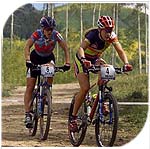|
|
| A good start is the key to a good finish | |
Often in mountain biking, the start is key to your overall placing in the race. How you warm up, line up and approach the first few hundreds yards of the race are key to reaching the first singletrack section in the first group — if that's your goal. A cross-country mountain-bike race is a highly aerobic event that starts with a field sprint. Although you'll eventually need to pace yourself for the distance, your start must be fast to get ahead of the inevitable bottleneck where the singletrack sections begin. This makes it important to warm up well and then get to the starting area in time for a place in or near the front line. Warm up for 30 to 45 minutes, including 25 minutes of easy riding and a couple of gradually increasing efforts of one to two minutes. Take your heart rate to about 80 to 90 percent of maximum during these hard efforts. Then ride easy for about five minutes to cool down. This helps remove most of the lactic acid that has built up in your legs during the hard efforts. If possible, line up in the front row — but know that only a fraction of the field will fit there. It is best to line up near the front but toward the side of the line. If other racers tangle handlebars and pile up in front of you, it's easier to go around the outside of the pile-up. If the course quickly turns to the right or left after the start, line up on the opposite side of the field (left or right, respectively) so you can go around congestion in the apex. It helps to watch the other classes of racers start, and learn from what you see. Pick the right gear A low gear may be good for the first 10 to 20 yards, but then you'll lose ground to the lead group. A low gear may also make it difficult to locate your pedal and clip in, because you won't be exerting much downward pressure. Conversely, a gear that's too high will prevent fast acceleration. By the time you get up to speed, many people will have ridden around you. Practice 50- to 75-yard starts to find the gears and techniques that work best for starting. Pick the right pace As important as technique is at the start, how hard you exert yourself is just as important. The start always requires a hard effort, but let's say the course is fairly open for a mile or so before it narrows down. You can afford to leave the line a bit slower to avoid going anaerobic, then pick up your speed gradually. Quite a few cyclists may pass you, but as you pace yourself, you'll soon be passing them. You'll get some of them back before the singletrack starts. By holding back early, you have more left during the latter part of the race when the fast starters are fighting off lactic-acid buildup. If your start isn't good and you find yourself near the back of the field, forget about drafting. Instead, move toward the side where you have the clearest path for passing. This also will keep you out of the pileups that happen when someone's screw-up causes a chain reaction through the pack. Look for a good wheel to draft if the speed is high and it's a long way to the singletrack. As on the road, drafting lets you ride with about 20 to 30 percent less effort than the cyclist in front. If he begins to blow up, he'll take you back with him. Should you sense this happening, get around him right away and latch onto a different locomotive. It is very important to be aggressive about holding the position at the start. If you back off when a cyclist comes up beside you, you'll be at the rear of the field in no time. Keep your speed and let other racers know that you're not going anywhere but forward. Attitude counts for a lot. Make your competitors work hard to get past you. Good Luck! |

